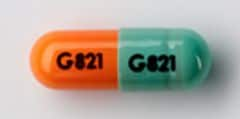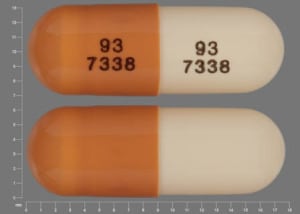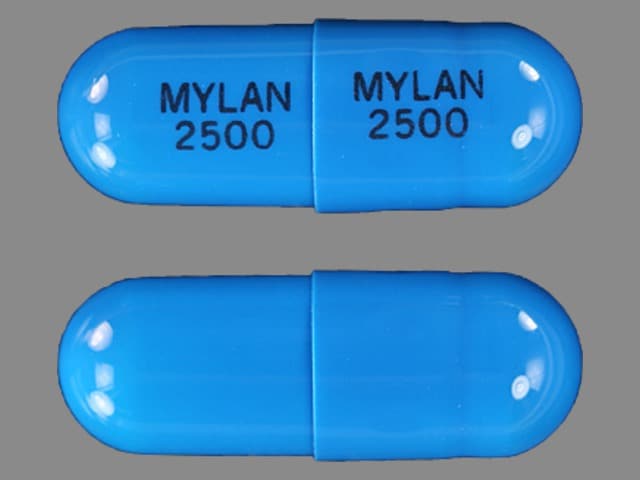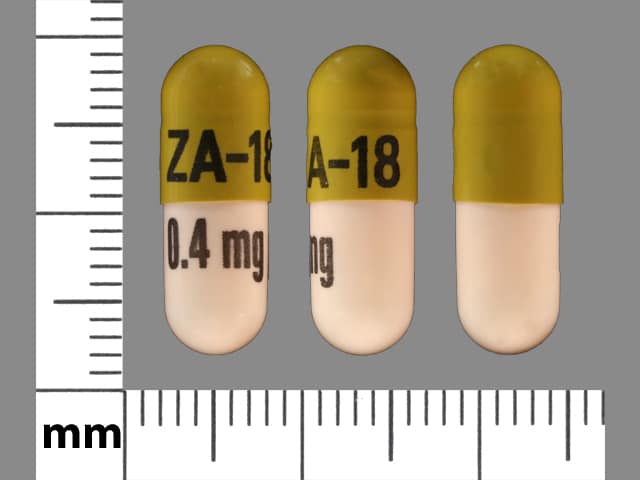Dosage Forms
Excipient information presented when available (limited, particularly for generics); consult specific product labeling.
Capsule, Oral, as hydrochloride:
Flomax: 0.4 mg [contains fd&c blue #2 (indigotine)]
Generic: 0.4 mg
Pharmacology
Mechanism of Action
Tamsulosin is an antagonist of alpha1A-adrenoreceptors in the prostate. Smooth muscle tone in the prostate is mediated by alpha1A-adrenoreceptors; blocking them leads to relaxation of smooth muscle in the bladder neck and prostate causing an improvement of urine flow and decreased symptoms of BPH. Approximately 75% of the alpha1-receptors in the prostate are of the alpha1A subtype.
Pharmacokinetics/Pharmacodynamics
Absorption
>90%
Distribution
Vd: 16 L
Metabolism
Hepatic (extensive) via CYP3A4 and 2D6; metabolites undergo extensive conjugation to glucuronide or sulfate
Excretion
Urine (76%, <10% as unchanged drug); feces (21%)
Time to Peak
Fasting: 4 to 5 hours; With food: 6 to 7 hours
Steady-state: By the fifth day of once-daily dosing
Half-Life Elimination
Healthy volunteers: 9 to 13 hours; Target population: 14 to15 hours
Protein Binding
94% to 99%, primarily to alpha-1 acid glycoprotein (AAG)
Use in Specific Populations
Special Populations: Elderly
AUC is 40% higher in subjects 55 to 75 years of age compared with subjects 20 to 32 years of age.
Use: Labeled Indications
Benign prostatic hyperplasia: Treatment of signs and symptoms of benign prostatic hyperplasia (BPH)
Limitations of use: Not indicated for the treatment of hypertension.
Use: Off Label
Chronic prostatitis/chronic pelvic pain syndrome (CP/CPPS) in malesc
Data from a meta-analysis and clinical experience suggests the utility of tamsulosin, in combination with antibiotics, for improvement in symptoms (eg, pain, urinary symptoms) associated with CP/CPPS Anothaisintawee 2011, Pontari 2018.
Lower urinary tract symptoms (LUTS) in malesb
Data from a prospective, randomized, controlled study in males with lower urinary tract symptoms suggestive of bladder outlet obstruction (BOO) and concomitant detrusor instability receiving tamsulosin in combination with an anticholinergic agent showed an improvement in quality of life Athanasopoulos 2003.
Ureteral calculi expulsionayes
Use of alpha-1 blockers, including tamsulosin, for treating ureteral calculi is supported by data from meta-analyses as well as numerous controlled trials. Tamsulosin has been shown to be effective in facilitating expulsion of ureteral stones (<10 mm) as medical therapy alone or as an adjunct to shock wave lithotripsy and ureteroscopy. Some trials indicate a class effect of alpha-1 adrenergic blockers, with tamsulosin reported to be equally effective as terazosin, doxazosin, and alfuzosin Campshroer 2018, Fan 2013, Furyk 2016, Hollingsworth 2016, Ye 2011, Ye 2017.
American Urological Association/Endourological Society guidelines and European Association of Urology guidelines recommend use of alpha-1 blockers, including tamsulosin, for treating ureteral calculi
Ureteral stent-related urinary symptoms, treatmentb
Data from prospective, randomized trials and a meta-analysis support the use of tamsulosin for improvement in stent-related urinary symptoms and quality of life in patients undergoing ureteral stent placement Damiano 2008, Wang 2009a, Wang 2009b, Yakoubi 2011.
Contraindications
Hypersensitivity (eg, angioedema, rash, urticaria, pruritus, respiratory symptoms) to tamsulosin or any component of the formulation
Canadian labeling: Additional contraindications (not in US labeling): Concomitant use with strong CYP3A4 inhibitors (including ketoconazole)
Dosage and Administration
Dosing: Adult
Note: Tamsulosin capsules should be administered ~30 minutes following the same meal each day. The controlled-release (oral controlled absorption system [OCAS]) tablet formulation [Canadian product] should be administered at the same time each day with or without food.
Benign prostatic hyperplasia (BPH): Oral:
Capsule: Initial and Maintenance: 0.4 mg once daily. If response is inadequate after 2 to 4 weeks, may increase to 0.8 mg once daily. If therapy is discontinued or interrupted for several days, restart with 0.4 mg once daily.
Controlled-release tablet [Canadian product]: Initial and maximum dose: 0.4 mg once daily
Chronic prostatitis/chronic pelvic pain syndrome (CP/CPPS) in males (off-label use): Oral: Initial: 0.4 mg once daily in combination with antibiotic treatment; antibiotic is given for initial 6 weeks (Pontari 2018). If response to initial therapy is inadequate, referral to a urologist is recommended (Anothaisintawee 2011; Nickel 2012; Pontari 2018).
Lower urinary tract symptoms (LUTS) in males (off-label use): Bladder outlet obstruction (BOO) and low postvoid residual (PVR): Oral: Initial: 0.4 mg once daily; may combine with an anticholinergic agent if symptoms of overactive bladder persist (Athanasopoulos 2003; Dimitropoulos 2015; Drake 2015; Van Kerrebroeck 2013).
Ureteral calculi expulsion (off-label use):
Medical expulsive therapy (MET) for distal (lower) ureteral calculi to facilitate spontaneous stone passage: Stones >5 and ≤10 mm: Oral: 0.4 mg once daily until stone passage occurs or for up to 4 weeks (Ahmed 2010; Campschroer 2014; Hollingsworth 2016; Ye 2017).
Adjunctive therapy following shock wave lithotripsy to facilitate clearance of residual stones: Oral: 0.4 mg once daily; initiate therapy immediately after extracorporeal shock wave lithotripsy; duration of therapy in trials ranged from 14 days to 3 months (Agrawal 2009; Chen 2015; Falahatkar 2011; Vicentini 2011).
Ureteral stent-related urinary symptoms, treatment (off-label use): Oral: 0.4 mg once daily; treatment was initiated following stent placement and duration of therapy in trials ranged from 1 to 6 weeks (Damiano 2008; Wang 2009a; Wang 2009b; Yakoubi 2011); may also be given in combination with an anticholinergic agent (Dellis 2017).
Dosing: Geriatric
Refer to adult dosing.
Dosing: Pediatric
Nephrolithiasis, distal stones: Limited data available; optimal dose not established (Mokhless 2012; Tasian 2014):
Children 2 to 4 years: Oral: 0.2 or 0.4 mg once daily at bedtime
Children >4 years and Adolescents: Oral: 0.4 mg once daily at bedtime
Dosing based on two studies. The larger was a multi-institutional retrospective cohort study of pediatric patients with stones up to 10 mm; patients received either tamsulosin 0.4 mg once daily (n=99, median age: 14.8 years) or analgesics alone (n=175). Spontaneous stone passage was higher in the treatment group (55% vs 44%, p=0.03); treatment group was older and had smaller, more distal stones. When adjusted for stone size and location as part of analysis of 99 case matched pairs, success was also higher in the treatment group (OR 3.31, 95% CI: 1.49 to 7.34) (Tasian 2014). The smaller study was a prospective, randomized controlled trial of pediatric patients with stones up to 12 mm; patients received either tamsulosin 0.4 mg once daily (0.2 mg if ≤4 years old) (n=33, age: 2 to 15 years) or placebo (n=28). In this study, 45% of the treatment group had previously received either extracorporeal shock wave lithotripsy (ESWL) or percutaneous nephrolithotomy, but none in the control group had received these therapies; however, stone size at the start of treatment was similar between groups. Treatment resulted in higher expulsion rate (87.8% vs 64.2%, p<0.01), less days to expulsion (mean: 8.2 vs 14.5 days, p<0.001), less pain episodes (mean: 1.4 vs 2.2, p<0.02) and less need for analgesia (mean: 0.7 vs 1.4, p<0.02) (Mokhless 2012). In both studies, tamsulosin was well tolerated and there were no reported adverse effects.
Primary bladder neck dysfunction: Limited data available: Children ≥3 years and Adolescents: Oral: Initial dose: 0.2 mg once daily, increase by 0.2 mg increments based on response (symptoms and urodynamic studies) and tolerability. Mean effective dose: 0.4 mg daily; maximum reported daily dose: 0.8 mg/day. Dosing based on two trials evaluating treatment with alpha blockers, including over 50 pediatric patients who received tamsulosin. Treatment resulted in improved urine flow rates and decreased post-void residual urine volume; values returned to pretreatment levels when therapy was discontinued. Tamsulosin was well tolerated with no major adverse effects and benefits continued for at least 3 years (Donohoe 2005; Van Batavia 2010).
Administration
Oral: Administer capsules 30 minutes after the same mealtime each day. Capsules should be swallowed whole; do not crush, chew, or open. The controlled-release tablet [Canadian product] should be administered at the same time each day with or without food, and should be swallowed whole.
Storage
Store at 25°C (77°F); excursions are permitted between 15°C and 30°C (59°F and 86°F).
Tamsulosin Images
Drug Interactions
Alpha-/Beta-Agonists: Alpha1-Blockers may diminish the vasoconstricting effect of Alpha-/Beta-Agonists. Similarly, Alpha-/Beta-Agonists may antagonize Alpha1-Blocker vasodilation. Monitor therapy
Alpha1-Agonists: Alpha1-Blockers may diminish the vasoconstricting effect of Alpha1-Agonists. Similarly, Alpha1-Agonists may antagonize Alpha1-Blocker vasodilation. Monitor therapy
Alpha1-Blockers: May enhance the antihypertensive effect of other Alpha1-Blockers. Avoid combination
Amifostine: Blood Pressure Lowering Agents may enhance the hypotensive effect of Amifostine. Management: When amifostine is used at chemotherapy doses, blood pressure lowering medications should be withheld for 24 hours prior to amifostine administration. If blood pressure lowering therapy cannot be withheld, amifostine should not be administered. Consider therapy modification
Antipsychotic Agents (Second Generation [Atypical]): Blood Pressure Lowering Agents may enhance the hypotensive effect of Antipsychotic Agents (Second Generation [Atypical]). Monitor therapy
Aprepitant: May increase the serum concentration of CYP3A4 Substrates (High risk with Inhibitors). Monitor therapy
Barbiturates: May enhance the hypotensive effect of Blood Pressure Lowering Agents. Monitor therapy
Benperidol: May enhance the hypotensive effect of Blood Pressure Lowering Agents. Monitor therapy
Beta-Blockers: May enhance the orthostatic hypotensive effect of Alpha1-Blockers. The risk associated with ophthalmic products is probably less than systemic products. Exceptions: Levobunolol; Metipranolol. Monitor therapy
Blood Pressure Lowering Agents: May enhance the hypotensive effect of Hypotension-Associated Agents. Monitor therapy
Bosentan: May decrease the serum concentration of CYP3A4 Substrates (High risk with Inducers). Monitor therapy
Brimonidine (Topical): May enhance the hypotensive effect of Blood Pressure Lowering Agents. Monitor therapy
Bromperidol: Blood Pressure Lowering Agents may enhance the hypotensive effect of Bromperidol. Bromperidol may diminish the hypotensive effect of Blood Pressure Lowering Agents. Avoid combination
Calcium Channel Blockers: Alpha1-Blockers may enhance the hypotensive effect of Calcium Channel Blockers. Monitor therapy
Cimetidine: May increase the serum concentration of Tamsulosin. Monitor therapy
Clofazimine: May increase the serum concentration of CYP3A4 Substrates (High risk with Inhibitors). Monitor therapy
Conivaptan: May increase the serum concentration of CYP3A4 Substrates (High risk with Inhibitors). Avoid combination
CYP2D6 Inhibitors (Moderate): May increase the serum concentration of Tamsulosin. Monitor therapy
CYP2D6 Inhibitors (Strong): May increase the serum concentration of Tamsulosin. Monitor therapy
CYP3A4 Inducers (Moderate): May decrease the serum concentration of CYP3A4 Substrates (High risk with Inducers). Monitor therapy
CYP3A4 Inducers (Strong): May increase the metabolism of CYP3A4 Substrates (High risk with Inducers). Management: Consider an alternative for one of the interacting drugs. Some combinations may be specifically contraindicated. Consult appropriate manufacturer labeling. Consider therapy modification
CYP3A4 Inhibitors (Moderate): May increase the serum concentration of Tamsulosin. Monitor therapy
CYP3A4 Inhibitors (Strong): May increase the serum concentration of Tamsulosin. Avoid combination
Dabrafenib: May decrease the serum concentration of CYP3A4 Substrates (High risk with Inducers). Management: Seek alternatives to the CYP3A4 substrate when possible. If concomitant therapy cannot be avoided, monitor clinical effects of the substrate closely (particularly therapeutic effects). Consider therapy modification
Dapoxetine: May enhance the orthostatic hypotensive effect of Alpha1-Blockers. Monitor therapy
Deferasirox: May decrease the serum concentration of CYP3A4 Substrates (High risk with Inducers). Monitor therapy
Diazoxide: May enhance the hypotensive effect of Blood Pressure Lowering Agents. Monitor therapy
DULoxetine: Blood Pressure Lowering Agents may enhance the hypotensive effect of DULoxetine. Monitor therapy
Duvelisib: May increase the serum concentration of CYP3A4 Substrates (High risk with Inhibitors). Monitor therapy
Enzalutamide: May decrease the serum concentration of CYP3A4 Substrates (High risk with Inducers). Management: Concurrent use of enzalutamide with CYP3A4 substrates that have a narrow therapeutic index should be avoided. Use of enzalutamide and any other CYP3A4 substrate should be performed with caution and close monitoring. Consider therapy modification
Erdafitinib: May decrease the serum concentration of CYP3A4 Substrates (High risk with Inducers). Monitor therapy
Erdafitinib: May increase the serum concentration of CYP3A4 Substrates (High risk with Inhibitors). Monitor therapy
Fosaprepitant: May increase the serum concentration of CYP3A4 Substrates (High risk with Inhibitors). Monitor therapy
Fosnetupitant: May increase the serum concentration of CYP3A4 Substrates (High risk with Inhibitors). Monitor therapy
Fusidic Acid (Systemic): May increase the serum concentration of CYP3A4 Substrates (High risk with Inhibitors). Avoid combination
Herbs (Hypotensive Properties): May enhance the hypotensive effect of Blood Pressure Lowering Agents. Monitor therapy
Hypotension-Associated Agents: Blood Pressure Lowering Agents may enhance the hypotensive effect of Hypotension-Associated Agents. Monitor therapy
Idelalisib: May increase the serum concentration of CYP3A4 Substrates (High risk with Inhibitors). Avoid combination
Ivosidenib: May decrease the serum concentration of CYP3A4 Substrates (High risk with Inducers). Monitor therapy
Larotrectinib: May increase the serum concentration of CYP3A4 Substrates (High risk with Inhibitors). Monitor therapy
Levodopa-Containing Products: Blood Pressure Lowering Agents may enhance the hypotensive effect of Levodopa-Containing Products. Monitor therapy
Lorlatinib: May decrease the serum concentration of CYP3A4 Substrates (High risk with Inducers). Management: Avoid concurrent use of lorlatinib with any CYP3A4 substrates for which a minimal decrease in serum concentrations of the CYP3A4 substrate could lead to therapeutic failure and serious clinical consequences. Consider therapy modification
Lormetazepam: May enhance the hypotensive effect of Blood Pressure Lowering Agents. Monitor therapy
Mitotane: May decrease the serum concentration of CYP3A4 Substrates (High risk with Inducers). Management: Doses of CYP3A4 substrates may need to be adjusted substantially when used in patients being treated with mitotane. Consider therapy modification
Molsidomine: May enhance the hypotensive effect of Blood Pressure Lowering Agents. Monitor therapy
Netupitant: May increase the serum concentration of CYP3A4 Substrates (High risk with Inhibitors). Monitor therapy
Nicorandil: May enhance the hypotensive effect of Blood Pressure Lowering Agents. Monitor therapy
Nitroprusside: Blood Pressure Lowering Agents may enhance the hypotensive effect of Nitroprusside. Monitor therapy
Obinutuzumab: May enhance the hypotensive effect of Blood Pressure Lowering Agents. Management: Consider temporarily withholding blood pressure lowering medications beginning 12 hours prior to obinutuzumab infusion and continuing until 1 hour after the end of the infusion. Consider therapy modification
Palbociclib: May increase the serum concentration of CYP3A4 Substrates (High risk with Inhibitors). Monitor therapy
Pentoxifylline: May enhance the hypotensive effect of Blood Pressure Lowering Agents. Monitor therapy
Pholcodine: Blood Pressure Lowering Agents may enhance the hypotensive effect of Pholcodine. Monitor therapy
Phosphodiesterase 5 Inhibitors: May enhance the hypotensive effect of Blood Pressure Lowering Agents. Monitor therapy
Phosphodiesterase 5 Inhibitors: Alpha1-Blockers (Uroselective) may enhance the hypotensive effect of Phosphodiesterase 5 Inhibitors. Monitor therapy
Prostacyclin Analogues: May enhance the hypotensive effect of Blood Pressure Lowering Agents. Monitor therapy
Quinagolide: May enhance the hypotensive effect of Blood Pressure Lowering Agents. Monitor therapy
Rilmenidine: Alpha1-Blockers may enhance the hypotensive effect of Rilmenidine. Monitor therapy
Sarilumab: May decrease the serum concentration of CYP3A4 Substrates (High risk with Inducers). Monitor therapy
Siltuximab: May decrease the serum concentration of CYP3A4 Substrates (High risk with Inducers). Monitor therapy
Simeprevir: May increase the serum concentration of CYP3A4 Substrates (High risk with Inhibitors). Monitor therapy
Stiripentol: May increase the serum concentration of CYP3A4 Substrates (High risk with Inhibitors). Management: Use of stiripentol with CYP3A4 substrates that are considered to have a narrow therapeutic index should be avoided due to the increased risk for adverse effects and toxicity. Any CYP3A4 substrate used with stiripentol requires closer monitoring. Consider therapy modification
Tocilizumab: May decrease the serum concentration of CYP3A4 Substrates (High risk with Inducers). Monitor therapy
Adverse Reactions
>10%:
Cardiovascular: Orthostatic hypotension (first dose: 6% to 19%; symptomatic orthostatic hypotension (chronic therapy) <1%)
Central nervous system: Headache (19% to 21%), dizziness (15% to 17%)
Genitourinary: Ejaculation failure (8% to 18%)
Infection: Infection (9% to 11%)
Respiratory: Rhinitis (13% to 18%)
1% to 10%:
Central nervous system: Drowsiness (3% to 4%), insomnia (1% to 2%), vertigo (≤1%)
Endocrine & metabolic: Loss of libido (2%)
Gastrointestinal: Diarrhea (6%), nausea (4%)
Neuromuscular & skeletal: Weakness (8% to 9%), back pain (7% to 8%)
Ophthalmic: Blurred vision (≤2%)
Respiratory: Pharyngitis (6%), cough (3% to 5%), sinusitis (4%)
<1%, postmarketing, and/or case reports: Constipation, decreased visual acuity, epistaxis, erythema multiforme, exfoliation of skin, exfoliative dermatitis, hypersensitivity reaction, hypotension, intraoperative floppy iris syndrome, palpitations, priapism, syncope, vomiting, xerostomia
Warnings/Precautions
Concerns related to adverse effects:
- Angina: Discontinue if symptoms of angina occur or worsen.
- Floppy iris syndrome: Intraoperative floppy iris syndrome (IFIS) is characterized by a combination of flaccid iris that billows with intraoperative currents, progressive intraoperative miosis despite dilation, and potential iris prolapse. IFIS has been observed in cataract and glaucoma surgery patients who were on or were previously treated with alpha1-blockers, particularly with tamsulosin use (Abdel-Aziz 2009); in some cases, patients had discontinued the alpha1-blocker 5 weeks to 9 months prior to the surgery. The benefit of discontinuing alpha-blocker therapy prior to cataract or glaucoma surgery has not been established. IFIS may increase the risk of ocular complications during and after surgery. May require modifications to surgical technique; instruct patients to inform ophthalmologist of current or previous alpha1-blocker use when considering eye surgery. Initiation of tamsulosin therapy in patients with planned cataract or glaucoma surgery is not recommended.
- Orthostatic hypotension/syncope: May cause significant orthostatic hypotension and syncope, especially with first dose; anticipate a similar effect if therapy is interrupted for a few days, if dosage is rapidly increased, or if another antihypertensive drug (particularly vasodilators) or a PDE-5 inhibitor (eg, sildenafil, tadalafil, vardenafil) is introduced. “First-dose” orthostatic hypotension may occur 4 to 8 hours after dosing; may be dose related. Patients should be cautioned about performing hazardous tasks, driving, or operating heavy machinery when starting new therapy or adjusting dosage upward.
- Priapism: Priapism has been associated with use (rarely).
- Sulfonamide allergy: Rarely, patients with a sulfa allergy have also developed an allergic reaction to tamsulosin; avoid use when previous reaction has been severe or life-threatening.
Disease-related concerns:
- Heart failure: In a scientific statement from the American Heart Association, tamsulosin has been determined to be an agent that may exacerbate underlying myocardial dysfunction (magnitude: moderate) (AHA [Page 2016]).
- Prostate cancer: It is recommended to rule out prostatic carcinoma with screening before beginning therapy and then screen at regular intervals.
Concurrent drug therapy issues:
- Potentially significant interactions may exist, requiring dose or frequency adjustment, additional monitoring, and/or selection of alternative therapy. Consult drug interactions database for more detailed information.
Monitoring Parameters
Blood pressure; urinary symptoms
Pregnancy
Pregnancy Considerations
Information related to the use of tamsulosin for treating ureteral calculi in pregnancy is limited (Bailey 2016). Other treatments such as stents or ureteroscopy, are currently recommended if stone removal is needed (Assimos 2016; Lloyd 2016).
Patient Education
What is this drug used for?
- In men, it is used to treat the signs of an enlarged prostate.
- It may be given to you for other reasons. Talk with the doctor.
Frequently reported side effects of this drug
- Headache
- Back pain
- Diarrhea
- Runny nose
- Loss of strength and energy
Other side effects of this drug: Talk with your doctor right away if you have any of these signs of:
- Severe dizziness
- Passing out
- Chills
- Sore throat
- Sexual dysfunction
- Erection that lasts more than 4 hours
- Signs of a significant reaction like wheezing; chest tightness; fever; itching; bad cough; blue skin color; seizures; or swelling of face, lips, tongue, or throat.
Note: This is not a comprehensive list of all side effects. Talk to your doctor if you have questions.
Consumer Information Use and Disclaimer: This information should not be used to decide whether or not to take this medicine or any other medicine. Only the healthcare provider has the knowledge and training to decide which medicines are right for a specific patient. This information does not endorse any medicine as safe, effective, or approved for treating any patient or health condition. This is only a brief summary of general information about this medicine. It does NOT include all information about the possible uses, directions, warnings, precautions, interactions, adverse effects, or risks that may apply to this medicine. This information is not specific medical advice and does not replace information you receive from the healthcare provider. You must talk with the healthcare provider for complete information about the risks and benefits of using this medicine.




